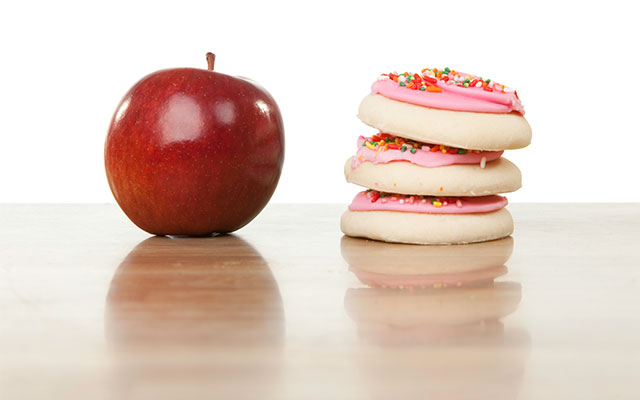The latest updates to the USDA Food Guidelines were released last week, and the recommendations around sugar consumption are getting a lot of attention. The guidelines, which are updated every five years, now suggest that Americans limit their intake of added sugars to less than 10 percent of their daily calories, or about 10 to 12 teaspoons per day for a 2,000 calorie diet.
The average American consumes some 22 teaspoons of sugar a day, with packaged beverages like sodas and sports drinks supplying almost half of added sugar intake, according to a 2015 report by the Dietary Guidelines Advisory Committee (DGAC).
A large amount of added sugar also lurks in countless other processed food sources, including breads, sauces, and salad dressings. Check out the amount in these commercial products.
Mark Hyman, MD, functional-medicine pioneer and director of the Cleveland Clinic’s Center for Functional Medicine, hailed the USDA’s revision as “the most powerful recommendation” of the latest guidelines on his Facebook page.
Beyond causing cavities, sugar is a major culprit in bodywide inflammation, fueling chronic diseases, and even increasing our risks of cancer. As freelancer Catherine Guthrie described for Experience Life in May 2011: “Sugar can contribute to cellular inflammation, which is like a continuing series of paper cuts that compromise cell function. Deep inside the body, these microscopic wounds fester below the pain threshold. Because many of us don’t see or feel the damage, there is little incentive to cut back on the inflammatory diet that is causing this constant cellular damage, so the party continues.”
A 2014 Centers for Disease Control and Prevention study, published in JAMA Internal Medicine, found that people whose sugar consumption made up 25 percent or more of their daily caloric intake had more than twice the risk of dying from cardiovascular disease than people whose sugar intake was less than 10 percent of their daily calories.
The trick to enjoying the sweet things in life is to ferret out hidden sugars and save small doses of sugar for dessert, where it belongs. “You can subtract grams and grams of sugar out of your diet without ever touching dessert,” says David Katz, MD, director and cofounder of the Yale-Griffin Prevention Research Center.
Other key shifts in the guidelines are a focus on consuming whole, nutrient-dense foods, which Hyman notes, “moves away from the confusion in past guidelines by highlighting whole foods, not just ingredients.”
Reversing a 50-year trend, the guidelines also moved away from previous recommendations about cholesterol, advising Americans simply to “eat as little dietary cholesterol as possible.”
“Cholesterol is not considered a nutrient of concern for overconsumption,” stated the DGAC in 2015.
10 Tips to Tame Your Sweet Tooth
- Treat all sugars equally. Yes, some sweeteners, like honey, maple syrup, and molasses, contain a few beneficial micronutrients. But, in the long run, putting health halos on some sweeteners and demonizing others only perpetuates an unhealthy addiction to sweets.
- Do the math. Food labels list sugar in grams. A gram of sugar is hard to picture, so divide the number of grams by 4. Four grams of sugar equals a teaspoon.
- Put protein, healthy fat, and fiber in the mix. All of them slow down the digestion process, averting blood-sugar spikes. Get creative by adding slow-digesting nutrients to your favorite sweets. If you’re going to have jam on your toast, make sure you’re also having an egg, some nut butter, or other fat with your breakfast. If you’re going to eat cereal, put some walnuts on it. Top pear slices with crumbled Gorgonzola. Choose dark chocolate, which contains some fat, over fat-free candies.
- Don’t fall for fake. Artificial sweeteners, often used in diet drinks, are noncaloric chemicals designed to stimulate the sweet receptors in the mouth. Aside from their questionable safety, a pressing concern is that these chemicals are up to 600 times sweeter than sugar itself.
- Curb omega-6 fatty acids. High levels of carbohydrates, including sugar, in the diet activate the enzymes that convert the omega-6 fatty acids found in common vegetable oils, such as soy, corn, and safflower oil, into arachidonic acid, the building block necessary to generate cellular inflammation.
- Limit fruit juice. Remember, it’s the fiber as well as the nutritional value that makes fruit a win-win. Fiber is what makes fruit filling. Depending on its size, an orange may pack up to 4 teaspoons of sugar, but that sugar is absorbed over a couple of hours. Compare that to the 8 teaspoons of sugar in 8 ounces of orange juice that is absorbed in 20 minutes.
- Prioritize low-sugar fruit. When it comes to sugar, not all fruits are created equal. Inside the body, some fruits, such as bananas, convert to sugar more quickly than others, like raspberries, clementines, and strawberries. That’s not to say you can’t enjoy a banana now and then, but just try not to overdo it. In addition, Frank Lipman, MD, offers these tips for curbing your sugar cravings:
- Add spices. Coriander, cinnamon, nutmeg, cloves, and cardamom will naturally sweeten your foods and reduce cravings.
- Eat regularly. Eat three meals and two snacks or five small meals a day. For many people, if they don’t eat regularly, their blood-sugar levels drop, they feel hungry, and they are more likely to crave sweet sugary snacks.
- Drink lots of water. Sometimes drinking water or seltzer water can help with sugar cravings. Also, sometimes what we perceive as a food craving is really thirst.




This Post Has 0 Comments